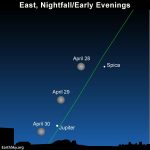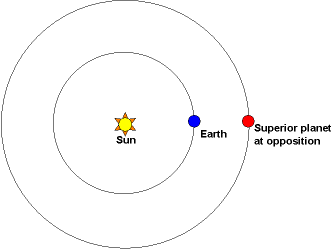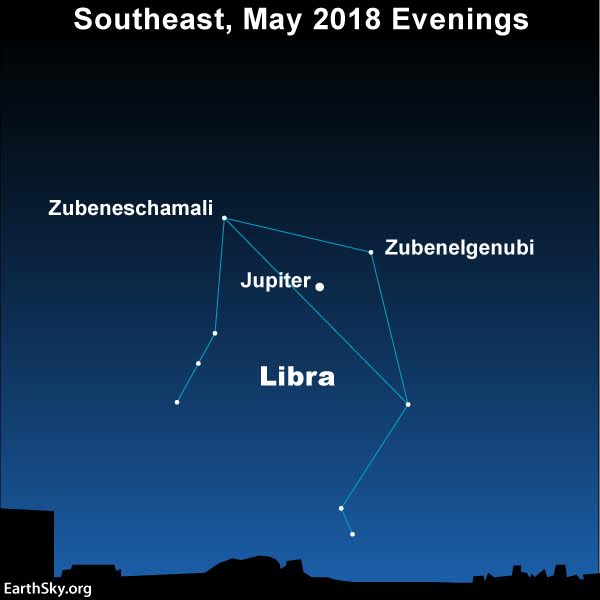
When night falls in the western hemisphere on April 30, 2018, the moon is about a day past full, but – from the whole Earth – it’ll still look bright and full in our sky. The April 30 moon is near the dazzling planet Jupiter, which – after the sun, moon and Venus – is the fourth-brightest celestial body to light up the heavens. Venus sets in the west at early evening, leaving the very bright moon and very bright Jupiter to rule the night. Also look for Spica, Virgo’s brightest star, above the moon and Jupiter in early evening.
Jupiter is now near its May 9 opposition, when Earth will fly between this outer planet and the sun. As seen from around the globe, Jupiter will be a very prominent sight in our eastern skies after sundown for the coming month. It’ll remain prominent through May and into June.
This is an awesome time to look at Jupiter with a telescope or binoculars. Learn to see Jupiter’s moons.

Opposition happens when Earth flies between an outer planet, like Jupiter, and the sun. This happens yearly for most of the outer planets (except Mars). Illustration via Heavens Above.
City or country – moon or no moon – Jupiter is easily visible, and we’re now in the middle of the best time of year to see it. It’s now rising in the east as Venus is setting in the west … stand outside at nightfall, and see if you can catch the two planets at the same time, Jupiter ascending in the east and Venus sinking behind the sunset.
Jupiter takes about 12 years to orbit the sun, and there are 12 constellations of the zodiac. So – traveling once around our sky every 12 years – Jupiter stays in any one zodiacal constellation for roughly a year. In 2018, it’s Libra’s turn. Use the moon to find Jupiter on April 30, then use Jupiter to find Libra for months to come.
Jupiter is now fairly close to Libra’s two brightest stars, Zubenelgenubi and Zubeneschamali, on the great dome of sky. Use Jupiter to more easily find these two modestly bright stars when the moon moves out of the evening sky in another few days.
You can’t miss Jupiter, but these Libra stars – without Jupiter – are a bit harder to locate. The chart below shows you how to find them in relationship to Jupiter:

Let Jupiter act as your guide “star” to the constellation Libra the Scales for many months to come!
How many of you have birthdays between October 31 and November 23? We ask because the sun shines in front of Libra at that time of year. This year, in 2018, the sun enters the constellation Libra on October 31 at 7 UTC and leaves Libra on November 23 at 12 UTC. Of course, this constellation is lost in the sun’s glare at that time of year, so you won’t be able to see Libra then.
The months of April and May are always better for viewing Libra than October or November. Find it now, and enjoy!
Bottom line: On April 30, 2018, enjoy the bright moon near Jupiter.
from EarthSky https://ift.tt/2r8wJHJ

When night falls in the western hemisphere on April 30, 2018, the moon is about a day past full, but – from the whole Earth – it’ll still look bright and full in our sky. The April 30 moon is near the dazzling planet Jupiter, which – after the sun, moon and Venus – is the fourth-brightest celestial body to light up the heavens. Venus sets in the west at early evening, leaving the very bright moon and very bright Jupiter to rule the night. Also look for Spica, Virgo’s brightest star, above the moon and Jupiter in early evening.
Jupiter is now near its May 9 opposition, when Earth will fly between this outer planet and the sun. As seen from around the globe, Jupiter will be a very prominent sight in our eastern skies after sundown for the coming month. It’ll remain prominent through May and into June.
This is an awesome time to look at Jupiter with a telescope or binoculars. Learn to see Jupiter’s moons.

Opposition happens when Earth flies between an outer planet, like Jupiter, and the sun. This happens yearly for most of the outer planets (except Mars). Illustration via Heavens Above.
City or country – moon or no moon – Jupiter is easily visible, and we’re now in the middle of the best time of year to see it. It’s now rising in the east as Venus is setting in the west … stand outside at nightfall, and see if you can catch the two planets at the same time, Jupiter ascending in the east and Venus sinking behind the sunset.
Jupiter takes about 12 years to orbit the sun, and there are 12 constellations of the zodiac. So – traveling once around our sky every 12 years – Jupiter stays in any one zodiacal constellation for roughly a year. In 2018, it’s Libra’s turn. Use the moon to find Jupiter on April 30, then use Jupiter to find Libra for months to come.
Jupiter is now fairly close to Libra’s two brightest stars, Zubenelgenubi and Zubeneschamali, on the great dome of sky. Use Jupiter to more easily find these two modestly bright stars when the moon moves out of the evening sky in another few days.
You can’t miss Jupiter, but these Libra stars – without Jupiter – are a bit harder to locate. The chart below shows you how to find them in relationship to Jupiter:

Let Jupiter act as your guide “star” to the constellation Libra the Scales for many months to come!
How many of you have birthdays between October 31 and November 23? We ask because the sun shines in front of Libra at that time of year. This year, in 2018, the sun enters the constellation Libra on October 31 at 7 UTC and leaves Libra on November 23 at 12 UTC. Of course, this constellation is lost in the sun’s glare at that time of year, so you won’t be able to see Libra then.
The months of April and May are always better for viewing Libra than October or November. Find it now, and enjoy!
Bottom line: On April 30, 2018, enjoy the bright moon near Jupiter.
from EarthSky https://ift.tt/2r8wJHJ

Aucun commentaire:
Enregistrer un commentaire